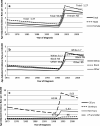Changing incidence of myeloproliferative neoplasms: trends and subgroup risk profiles in the USA, 1973-2011
- PMID: 25968903
- PMCID: PMC11824035
- DOI: 10.1007/s00432-015-1983-5
Changing incidence of myeloproliferative neoplasms: trends and subgroup risk profiles in the USA, 1973-2011
Abstract
Purpose: Recent diagnostic and cancer reporting changes influencing myeloproliferative neoplasms (MPNs) encourage the assessment of trends and examination of the recently identified MPN subtypes: polycythemia vera (PV), essential thrombocythemia (ET), and primary myelofibrosis (PMF), across the age continuum by race and ethnicity.
Methods: Surveillance, Epidemiology, and End Results data provided MPN incidence data since 1973 and MPN subtype data since 2001. Joinpoint regression estimated annual percent changes. Poisson regression estimated risk ratios.
Results: The 2005 JAK2 V617F discovery and the 2008 WHO diagnostic guideline for the JAK2 V617F mutation coincide with a 31 % increase in ET and a 21 % decrease in PV incidence rates. We found that younger women had a 13-33 % higher ET risk and that women under the age of 34 had a 58 % higher PMF risk, relative to men. Blacks, aged 35-49 with a higher ET risk, also had a 69 % higher PMF risk relative to whites.
Conclusion: Demographic characteristic of ET and PMF patients may be useful for improving risk prediction and informing clinical screening and treatment strategies. Changing guidelines, new discoveries, and in-depth analysis of a large population-based study have implications for accurately identifying incident cases of MPNs, MPN subgroups, and health resource planning.
Keywords: Essential thrombocythemia; Incidence; Myeloproliferative neoplasm; Polycythemia vera; Primary myelofibrosis; Trends.
Figures
References
-
- Alvarez-Larrán BB, Pereira A, Kerguelen A, Hernández-Boluda JC, Martínez-Avilés L et al (2014) JAK2V617F monitoring in polycythemia vera and essential thrombocythemia: clinical usefulness for predicting myelofibrotic transformation and thrombotic events. Am J Hematol 89:517–523 - PubMed
-
- Anderson LA, McMullin MF (2014) Epidemiology of MPN: what do we know. Curr Hematol Malig Rep 9:340–349 - PubMed
-
- Bain BJ (2004) The World Health Organization classification of myeloproliferative and myelodysplastic syndromes. Curr Diagn Pathol 10:394–403
MeSH terms
Substances
LinkOut - more resources
Full Text Sources
Miscellaneous


